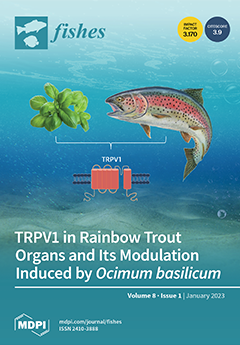The pelagic stingray (
Pteroplatytrygon violacea), perhaps the only stingray to inhabit open ocean waters, is highly interactive with longline and purse seine fisheries. The threat to
P. violacea posed by high bycatch mortality has received widespread attention. To date, the environmental
[...] Read more.
The pelagic stingray (
Pteroplatytrygon violacea), perhaps the only stingray to inhabit open ocean waters, is highly interactive with longline and purse seine fisheries. The threat to
P. violacea posed by high bycatch mortality has received widespread attention. To date, the environmental preference of
P. violacea, which is important in designing conservation and management measures, has not been well studied. Based on data collected during a 2016–2019 survey in the Pacific Ocean by national observers of tuna longline fisheries, the relationship between the presence of
P. violacea and spatiotemporal and environmental variables was first analyzed using the Generalized Additive Model. The results showed that geographic location (latitude and longitude) was the most influential variable. Monthly,
P. violacea is frequently present in the Pacific high sea from December to May. The El Niño–Southern Oscillation had a significant impact on the presence of
P. violacea in the Pacific high sea, with both the cold (Ocean Nino Index <−0.5) and warm (Ocean Nino Index >1) phases leading to a decrease in its presence. Regarding the environmental factors, we found that high presence was associated with low salinity (33.0~34.5 psu), a relatively high concentration of chlorophyll (0.2–0.35 mg/m
3), and warm water (>20 °C).
P. violacea was most likely observed in the waters offshore, closer to seamounts, and with water depths between 4000 and 5000 m. Four areas, including those east of the Solomon Islands and east of Kiribati, areas west of the Galapagos Islands, and areas near the coastal upwelling of northern Peru, related to upwelling systems or seamounts, were identified as the potential key habitats of
P. violacea. Predicted distribution maps showed a significant seasonal variation in the presence of
P. violacea. Moreover, the yearly change in the presence of
P. violacea in the Pacific high sea indicated a possible decreasing trend in recent years. The information first provided here is essential for developing conservation and management measures for
P. violacea to prevent the unavoidable ecological consequences of bycatch or other anthropogenic factors.
Full article





